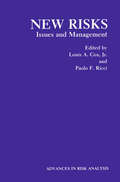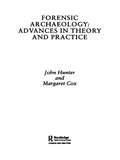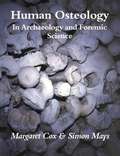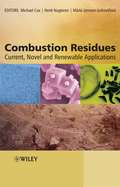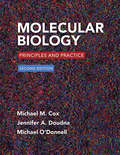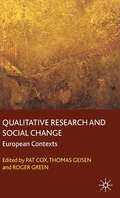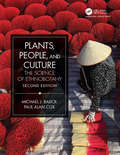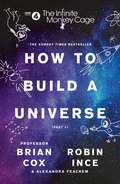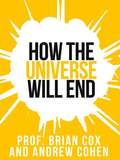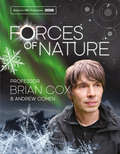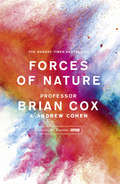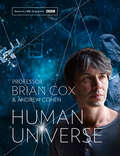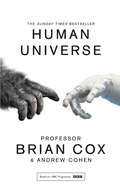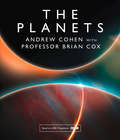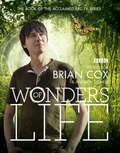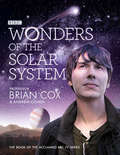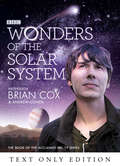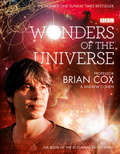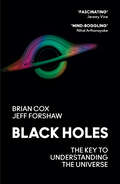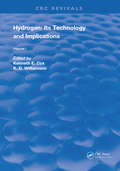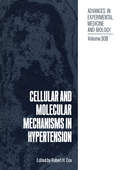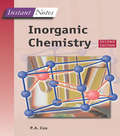- Table View
- List View
New Risks: Issues and Management (Advances in Risk Analysis #6)
by Louis A. Cox Paolo F. RicciThis volume contains the proceedings of the 1986 annual meeting and conference of the Society for Risk Analysis. It provides a detailed view of both mature disciplines and emerging areas within the fields of health, safety, and environmental risk analysis as they existed in 1986. In selecting and organizing topics for this conference, we sought both (i) to identify and include new ideas and application areas that would be of lasting interest to risk analysts and to users of risk analysis results, and (ii) to include innovative methods and applications in established areas of risk analysis. In the three years since the conference, many of the topics presented there for the first time to a broad risk analysis audience have become well developed-and sometimes hotly debated-areas of applied risk research. Several, such as the public health hazards from indoor air pollutants, radon in the home, high-voltage electric fields, and the AIDS epidemic, have been the subjects of headlines since 1986. Older areas, such as hazardous waste site ranking and remediation, air emissions dispersion modeling and exposure assessment, transportation safety, seismic and nuclear risk assessment, and occupational safety in the chemical industry, have continued to receive new treatments and to benefit from advances in quantitative risk assessment methods, as documented in the theoretical and methodological papers in this volume. A theme of the meeting was the importance of new technologies and the new and uncertain risks that they create.
Forensic Archaeology: Advances in Theory and Practice
by Margaret Cox John HunterThis updated edition of a textbook universally hailed as an indispensable guide, is a complete introduction to the methods and means of forensic archaeology. Incorporating new advances in the field, new case studies, and charting the growth and development of the subject, Forensic Archaeology examines the four main fields of recovery, search, skeletal analysis and analytical science, and how the concepts and methods of traditional archaeology can by utilized within criminal investigations. The authors provide in-depth chapters that discuss: search and location the various constraints and issues posed by an increasingly complex legal environment the archaeology of individual and mass graves how the subject has evolved to include international investigations of human rights links with forensic anthropology forensic geophysical survey. This is an invaluable resource that will provide students, researchers, academics and the general reader alike with a fascinating introduction to this complex and crucial subject.
Forensic Archaeology: Advances in Theory and Practice
by Margaret Cox John HunterThis updated edition of a textbook universally hailed as an indispensable guide, is a complete introduction to the methods and means of forensic archaeology. Incorporating new advances in the field, new case studies, and charting the growth and development of the subject, Forensic Archaeology examines the four main fields of recovery, search, skeletal analysis and analytical science, and how the concepts and methods of traditional archaeology can by utilized within criminal investigations. The authors provide in-depth chapters that discuss: search and location the various constraints and issues posed by an increasingly complex legal environment the archaeology of individual and mass graves how the subject has evolved to include international investigations of human rights links with forensic anthropology forensic geophysical survey. This is an invaluable resource that will provide students, researchers, academics and the general reader alike with a fascinating introduction to this complex and crucial subject.
Human Osteology: In Archaeology and Forensic Science (PDF)
by Margaret Cox Simon MaysThis advanced textbook provides the reader with an up-to-date account of recent developments and future potential in the study of human skeletons from both an archaeological and forensic context. It is well-illustrated, comprehensive in its coverage and is divided into six sections for ease of reference, encompassing such areas as palaeodemography, juvenile health and growth, disease and trauma, normal skeletal variation, biochemical and microscopic analyses and facial reconstruction. Each chapter is written by a recognised specialist in the field, and includes in-depth discussion of the reliability of methods, with appropriate references, and current and future research directions. It is essential reading for all students undertaking osteology as part of their studies and will also prove a valuable reference for forensic scientists, both in the field and the laboratory. 9780511043291
Combustion Residues: Current, Novel and Renewable Applications
by Michael Cox Mária Janssen-Jurkovicová Henk NugterenThe first book on novel products derived from the new generation of combustion ashes, Combustion Residues —Sustainable Applications discusses the nature of ashes derived from coal co-combustion, biomass, and other fuels in traditional and stand-alone power plants and municipal waste incinerators. In addition, the book examines the development of novel commercial products incorporating such ashes, including the importance of technical and environmental standards, marketing strategies, and promotion.
Molecular Biology: Principles and Practice
by Michael M. Cox Michael O'DonnellWritten and illustrated with unsurpassed clarity, Molecular Biology: Principles and Practice introduces fundamental concepts while exposing students to how science is done. The authors convey the sense of joy and excitement that comes from scientific discovery, highlighting the work of researchers who have shaped—and who continue to shape—the field today. The second edition addresses recent discoveries and advances, corresponding to our ever-changing understanding of molecular biology. There are numerous new figures and photos, along with significantly updated figures in every chapter. There are also new end-of-chapter questions for every chapter and many new Unanswered Questions. This textbook is available with LaunchPad. LaunchPad combines an interactive ebook with high-quality multimedia content and ready-made assessment options, including Learning Curve adaptive quizzing. See ‘Instructor Resources’ and ‘Student Resources’ for further information.
Qualitative Research and Social Change: European Contexts
by P. Cox T. Geisen R. GreenExploring the relationships between qualitative research and social change, this bookasks how social change is informed and influenced by research. Examples discussed are from research practice and experiences in the fields of sociology, social work, professional practice, education, criminal justice and anthropology."
Plants, People, and Culture: The Science of Ethnobotany
by Paul Alan Cox Michael J BalickIs it possible that plants have shaped the very trajectory of human cultures? Using riveting stories of fieldwork in remote villages, two of the world’s leading ethnobotanists argue that our past and our future are deeply intertwined with plants. Creating massive sea craft from plants, indigenous shipwrights spurred the navigation of the world’s oceans. Today, indigenous agricultural innovations continue to feed, clothe, and heal the world’s population. One out of four prescription drugs, for example, were discovered from plants used by traditional healers. Objects as common as baskets for winnowing or wooden boxes to store feathers were ornamented with traditional designs demonstrating the human ability to understand our environment and to perceive the cosmos. Throughout the world, the human body has been used as the ultimate canvas for plant-based adornment as well as indelible design using tattoo inks. Plants also garnered religious significance, both as offerings to the gods and as a doorway into the other world. Indigenous claims that plants themselves are sacred is leading to a startling reformulation of conservation. The authors argue that conservation goals can best be achieved by learning from, rather than opposing, indigenous peoples and their beliefs. KEY FEATURES • An engrossing narrative that invites the reader to personally engage with the relationship between plants, people, and culture • Full-color illustrations throughout—including many original photographs captured by the authors during fieldwork • New to this edition—"Plants That Harm," a chapter that examines the dangers of poisonous plants and the promise that their study holds for novel treatments for some of our most serious diseases, including Alzheimer’s and substance addiction • Additional readings at the end of each chapter to encourage further exploration • Boxed features on selected topics that offer further insight • Provocative questions to facilitate group discussion Designed for the college classroom as well as for lay readers, this update of Plants, People, and Culture entices the reader with firsthand stories of fieldwork, spectacular illustrations, and a deep respect for both indigenous peoples and the earth’s natural heritage.
Plants, People, and Culture: The Science of Ethnobotany
by Paul Alan Cox Michael J BalickIs it possible that plants have shaped the very trajectory of human cultures? Using riveting stories of fieldwork in remote villages, two of the world’s leading ethnobotanists argue that our past and our future are deeply intertwined with plants. Creating massive sea craft from plants, indigenous shipwrights spurred the navigation of the world’s oceans. Today, indigenous agricultural innovations continue to feed, clothe, and heal the world’s population. One out of four prescription drugs, for example, were discovered from plants used by traditional healers. Objects as common as baskets for winnowing or wooden boxes to store feathers were ornamented with traditional designs demonstrating the human ability to understand our environment and to perceive the cosmos. Throughout the world, the human body has been used as the ultimate canvas for plant-based adornment as well as indelible design using tattoo inks. Plants also garnered religious significance, both as offerings to the gods and as a doorway into the other world. Indigenous claims that plants themselves are sacred is leading to a startling reformulation of conservation. The authors argue that conservation goals can best be achieved by learning from, rather than opposing, indigenous peoples and their beliefs. KEY FEATURES • An engrossing narrative that invites the reader to personally engage with the relationship between plants, people, and culture • Full-color illustrations throughout—including many original photographs captured by the authors during fieldwork • New to this edition—"Plants That Harm," a chapter that examines the dangers of poisonous plants and the promise that their study holds for novel treatments for some of our most serious diseases, including Alzheimer’s and substance addiction • Additional readings at the end of each chapter to encourage further exploration • Boxed features on selected topics that offer further insight • Provocative questions to facilitate group discussion Designed for the college classroom as well as for lay readers, this update of Plants, People, and Culture entices the reader with firsthand stories of fieldwork, spectacular illustrations, and a deep respect for both indigenous peoples and the earth’s natural heritage.
The Infinite Monkey Cage – How to Build a Universe: How To Build A Universe
by Prof. Brian Cox Robin Ince Alexandra FeachemThe Infinite Monkey Cage, the legendary BBC Radio 4 programme, brings you this irreverent celebration of scientific marvels. Join us on a hectic leap through the grand and bizarre ideas conjured up by human imagination, from dark matter to consciousness via neutrinos and earthworms.
Prof. Brian Cox’s How The Universe Will End (Collins Shorts #1)
by Professor Brian CoxCollins Shorts – insight in an instant.
Forces of Nature
by Professor Brian Cox Andrew CohenSunday Times Bestseller A breathtaking and beautiful exploration of our planet, this groundbreaking book accompanies the BBC One TV series, providing the deepest answers to the simplest questions. Recommended for viewing on a colour tablet.
Forces of Nature
by Professor Brian Cox Andrew CohenSunday Times Bestseller How did life on Earth begin? What is the nature of space and time? What are the chances that we will discover life on other worlds?
Human Universe
by Professor Brian Cox Andrew CohenTop ten Sunday Times Bestseller ‘Engaging, ambitious and creative’ Guardian Where are we? Are we alone? Who are we? Why are we here? What is our future?
Human Universe
by Professor Brian Cox Andrew CohenTop ten Sunday Times Bestseller ‘Engaging, ambitious and creative’ Guardian Where are we? Are we alone? Who are we? Why are we here? What is our future?
The Planets
by Professor Brian Cox Andrew Cohen‘Absolutely beautiful’ BBC One Show ‘Really impressive’ Eamonn Holmes, ITV This Morning A companion book to the critically acclaimed BBC series.
Wonders of Life: Exploring The Most Extraordinary Phenomenon In The Universe (Wonders Ser.)
by Professor Brian Cox Andrew CohenWhat is Life? Where did it come from? Why does it end?
Wonders of the Solar System (Wonders Ser.)
by Professor Brian Cox Andrew CohenRecommended for viewing on a colour tablet. In Wonders of the Solar System – the book of the acclaimed BBC TV series – Professor Brian Cox will take us on a journey of discovery where alien worlds from your imagination become places we can see, feel and visit.
Wonders of the Solar System Text Only
by Professor Brian Cox Andrew CohenThe Sunday Times Bestseller In Wonders of the Solar System – the book of the acclaimed BBC TV series – Professor Brian Cox will take us on a journey of discovery where alien worlds from your imagination become places we can see, feel and visit.
Wonders of the Universe (Wonders Ser.)
by Professor Brian Cox Andrew CohenRecommended for viewing on a colour tablet. Professor Brian Cox is back with another insightful and mind-blowing exploration of space. This time he shows us our universe as we've never seen it before.
Black Holes: The Key To Understanding The Universe
by Professor Brian Cox Professor Jeff ForshawA Brief History of Time for the 21st Century At the heart of our galaxy lies a monster so deadly, not even light can escape its grasp. Its secrets lie waiting to be discovered. It’s time to explore our universe’s most mysterious inhabitants Black Holes
Hydrogen: Production Technology - Volume I
by R I CoxVolume I of this series discusses such topics as hydrogen production from fossil fuels, nuclear energy, and solar energy. Hydrogen production technology from water by traditional methods such as water electrolysis and newer attempts to split water thermochemically are included with details of current research efforts and future directions.This series in 5 volumes represents a serious attempt at providing information on all aspects of hydrogen at the postgraduate and professional level. It discusses recent developments in the science and technology of hydrogen production; hydrogen transmission and storage; hydrogen utilization; and the social, legal, political environmental, and economic implications of hydrogen‘s adoption as an energy medium.
Hydrogen: Production Technology - Volume I
by R I CoxVolume I of this series discusses such topics as hydrogen production from fossil fuels, nuclear energy, and solar energy. Hydrogen production technology from water by traditional methods such as water electrolysis and newer attempts to split water thermochemically are included with details of current research efforts and future directions.This series in 5 volumes represents a serious attempt at providing information on all aspects of hydrogen at the postgraduate and professional level. It discusses recent developments in the science and technology of hydrogen production; hydrogen transmission and storage; hydrogen utilization; and the social, legal, political environmental, and economic implications of hydrogen‘s adoption as an energy medium.
Cellular and Molecular Mechanisms in Hypertension (Advances in Experimental Medicine and Biology #308)
by Robert H. CoxHypertension is recognized to be one of the major risk factors for the development of peripheral vascular disease. The last decade has witnessed several major advances in therapy for hypertension, including the development of angiotensin-converting enzyme inhibitors and calcium channel blockers. These compounds have greatly improved the ability to control blood pressure and to reduce the impact of this risk factor on morbidity and mortality. In spite of these advances, cardiovascular disease remains a major health problem in most modern industrialized countries with related deaths exceeding those from all other causes combined. In contrast to these advances in therapy, our understanding of the basic mechanisms responsible for the pathogenesis of hypertension remains incomplete. Recent studies have produced new insights into the nature of the regulation of muscle contraction in both heart and blood vessels as well as the changes in muscle function that occur in hypertension. However, the effects of antihypertensive therapy, both in terms of restoring normal function and in producing reversal of hypertension-associated changes, has not been as thoroughly studied, especially in the vasculature. Studies in the heart suggest that the efficacy of different therapeutic agents in restoring normal function and reversing hypertensive changes vary substantially with the mechanism of action of the therapeutic agent. It has also been recently determined that some therapeutic agents produce adverse effects on plasma lipid profiles, which could lead to the secondary acceleration of the atherosclerotic process, while at the same time normalizing blood pressure.
BIOS Instant Notes in Inorganic Chemistry (Instant Notes)
by Tony CoxInstant Notes in Inorganic Chemistry, second edition has been fully updated and new material added on developments in noble-gas chemistry and the synthesis, reactions and characterization of inorganic compounds. New chapters cover the classification of inorganic reaction types concentrating on those useful in synthesis; techniques used in characterizing compounds, including elemental analysis; spectroscopic methods (IR, NMR) and structure determination by X-ray crystallography; and the factors involved in choosing appropriate solvents for synthetic reactions.The new edition continues to provide concise coverage of inorganic chemistry at an undergraduate level, offering easy access to all important areas of inorganic chemistry in a format which is ideal for learning and rapid revision.
